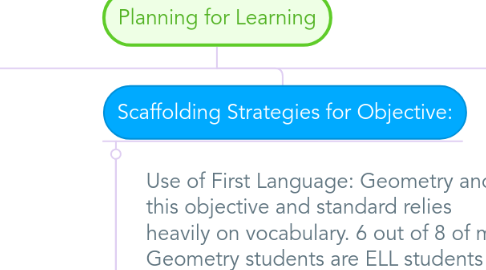Planning for Learning
by Naira Trolle

1. Standard: G-CO.9 from Common Core State Standards for Mathematics Prove theorems about lines and angles. Theorems include: vertical angles are congruent; when a transversal crosses parallel lines, alternate interior angles are congruent and corresponding angles are congruent; points on a perpendicular bisector of a line segment are exactly those equidistant from the segment’s endpoints.
1.1. 10th grade Geometry
1.2. Objective: Use theorems about pairs of angles, right angles and midpoints.
1.3. Big Ideas Students Should Know:
1.3.1. Naming angles: As students learned in Chapter 1 angles can be addressed by numbers and three letters, where the letter in the middle is the vertex. We can shorten this label to only the middle letter if there is only one angle with that vertex
1.3.2. Right Angle Theorem: If two angles are right angles, then the angles are congruent.
1.3.3. Same Angle Supplements Theorem: If two angles are supplementary to the same angle then the angles are congruent.
2. Scaffolding Strategies for Objective:
2.1. Use of First Language: Geometry and this objective and standard relies heavily on vocabulary. 6 out of 8 of my Geometry students are ELL students and I occasionally translate things in Spanish for them to make connections to their prior knowledge
2.2. Realia: Again, Geometry is basically a stu study of how lines and points relate in the real world. Often I find myself referring to walls, ceilings, floors, ropes, ladders, bridges, strings, rulers as examples to demonstrate geometric terms.
2.3. Pre-Teach Vocabulary: Since vocabulary is very important, I like for students to keep a special section of their binders for postulates, theorems, and terms so that they have a personalized glossary of definitions
2.4. Pause, Ask questions, Pause Review: In order to break the lecture I always pause and ask questions, and then review what I lectured for the past 20 minutes. Then I continue referring to my instruction materials for the lecture.
3. Key Factors About Students:
3.1. The key factors about my students is that they the majority of them are ELL students; that is why I chose a heavy focus on vocabulary and making connections to their first language which is Spanish. For the most part their Math foundations and algebra base are good, what is blocking them from engaging in classes is the lack of understanding of the language, not the mathematical concepts. That is why I chose these scaffolding strategies.


